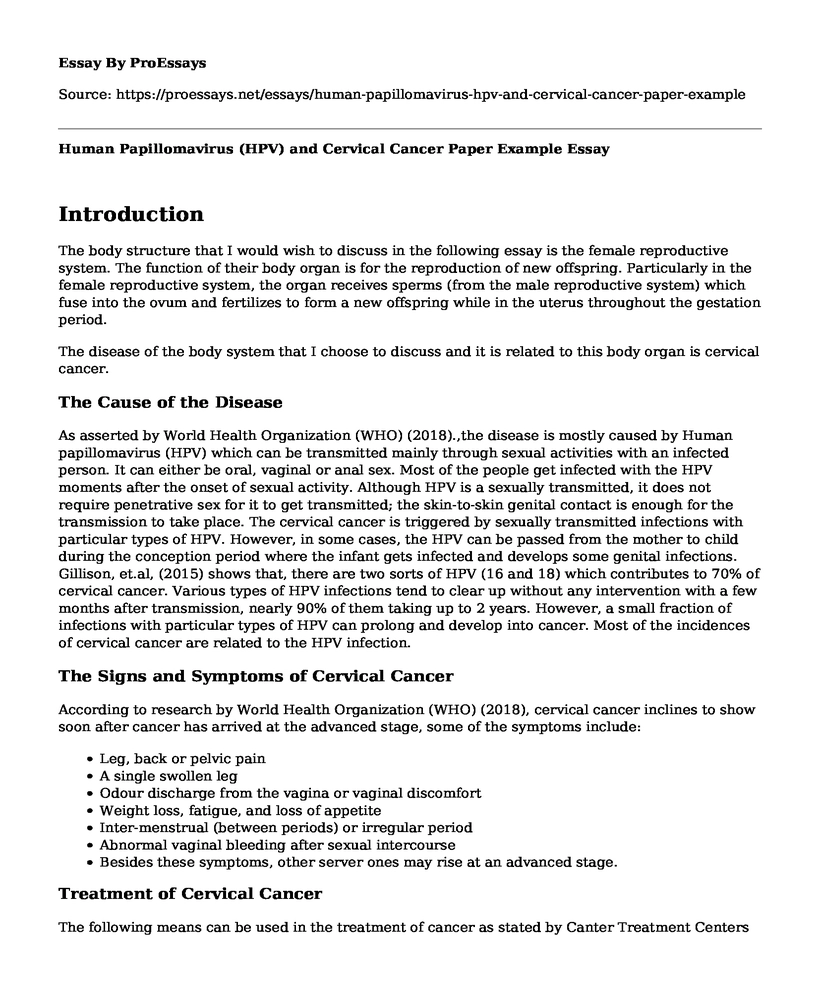Introduction
The body structure that I would wish to discuss in the following essay is the female reproductive system. The function of their body organ is for the reproduction of new offspring. Particularly in the female reproductive system, the organ receives sperms (from the male reproductive system) which fuse into the ovum and fertilizes to form a new offspring while in the uterus throughout the gestation period.
The disease of the body system that I choose to discuss and it is related to this body organ is cervical cancer.
The Cause of the Disease
As asserted by World Health Organization (WHO) (2018).,the disease is mostly caused by Human papillomavirus (HPV) which can be transmitted mainly through sexual activities with an infected person. It can either be oral, vaginal or anal sex. Most of the people get infected with the HPV moments after the onset of sexual activity. Although HPV is a sexually transmitted, it does not require penetrative sex for it to get transmitted; the skin-to-skin genital contact is enough for the transmission to take place. The cervical cancer is triggered by sexually transmitted infections with particular types of HPV. However, in some cases, the HPV can be passed from the mother to child during the conception period where the infant gets infected and develops some genital infections. Gillison, et.al, (2015) shows that, there are two sorts of HPV (16 and 18) which contributes to 70% of cervical cancer. Various types of HPV infections tend to clear up without any intervention with a few months after transmission, nearly 90% of them taking up to 2 years. However, a small fraction of infections with particular types of HPV can prolong and develop into cancer. Most of the incidences of cervical cancer are related to the HPV infection.
The Signs and Symptoms of Cervical Cancer
According to research by World Health Organization (WHO) (2018), cervical cancer inclines to show soon after cancer has arrived at the advanced stage, some of the symptoms include:
- Leg, back or pelvic pain
- A single swollen leg
- Odour discharge from the vagina or vaginal discomfort
- Weight loss, fatigue, and loss of appetite
- Inter-menstrual (between periods) or irregular period
- Abnormal vaginal bleeding after sexual intercourse
- Besides these symptoms, other server ones may rise at an advanced stage.
Treatment of Cervical Cancer
The following means can be used in the treatment of cancer as stated by Canter Treatment Centers of Americans CTCA. (2018):
- Medication procedure, they include Chemotherapy, Teletherapy, Brachytherapy, Radiation therapy, Loop electrosurgical excision procedure and cervical conization.
- Surgical methods: They include Hysterectomy, Cervicectomy, Cryosurgery, Lymph node dissection, and Retroperitoneal lymph node dissection.
- The medical specialists who are involved in the treatment of cervical cancer include OBGY Doctor, Oncologist, Radiation Oncologist and Primary Care Provider (PCP).
The spread of Cervical Cancer
As mentioned in the causes of the diseases, cervical cancer itself is not infectious but the causing agents HPV are contagious, and it is spread during sexual intercourse with an infected partner, not only through penetration but also through skin contact.
Research on Cervical Cancer
The research done by the National Cancer Institute (2018) states that the HPV vaccines assists in the prevention of infection from the HPV strains that lead to cervical cancer. Gardasil is an approved medication to prevent genital warts that are meant for boys and men between the ages of 9 to 26 years. Researchers are endeavoring at seeking the effect of the HPV vaccination on boys as the means to reduce HPV transmission.
Prognosis of Cervical Cancer
According to the American Cancer Society (2018), cervical cancer is both treatable and fatal. The five years survival rates for the people at stage 0 of cervical cancer is nearly 93%. While those at stage IA cervical cancer they have 93% of 5-year survival rate. The 5-year survival rate for the stage IB cancer is at around 80%. The 5-year survival rate for the stage IIA cancer is at around 63%.
References
National Cancer Institute. (2018). Retrieved from https://www.cancer.gov/about-cancer/causes-prevention/risk/infectious-agents/hpv-vaccine-fact-sheet
Gillison, M. L., Chaturvedi, A. K., Anderson, W. F., & Fakhry, C. (2015). Epidemiology of human papillomavirus-positive head and neck squamous cell carcinoma. Journal of Clinical Oncology, 33(29), 3235.
Canter Treatment Centers of Americans CTCA. (2018). Retrieved from https://www.cancercenter.com/cervical-cancer/symptoms/World Health Organization (WHO) (2018). Retrieved from http://www.who.int/news-room/fact-sheets/detail/human-papillomavirus-(hpv)-and-cervical-cancer
American Cancer Society. (2018). Retrieved from https://www.cancer.org/cancer/cervical-cancer/detection-diagnosis-staging/survival.html
Cite this page
Human Papillomavirus (HPV) and Cervical Cancer Paper Example. (2022, Jul 05). Retrieved from https://proessays.net/essays/human-papillomavirus-hpv-and-cervical-cancer-paper-example
If you are the original author of this essay and no longer wish to have it published on the ProEssays website, please click below to request its removal:
- Diagnosis of Diabetes
- Impacts of Collective Bargaining Agreement to the Public Essay
- Lapse of Ethics in Healthcare Paper Example
- Essay on Reaping Benefits of Disabled Worker Diversity: Tangible Benefits of Hiring Disabled Employees
- The Severity of Emissions From Vaping Vs. Smoking: A Comparative Study - Essay Sample
- Essay Sample on Rethinking Foster Care: Examining Challenges at the Micro-Level
- Case Study Analysis Example: Treatment & Task Groups







